Nikon D7000 vs Pentax K-5
Introduction
The Nikon D7000 and Pentax K-5 are currently the two best-performing cropped-sensor DSLRs. We already reviewed both and awarded each of them an Excellent rating. For those who missed them, the Nikon D7000 review is here and the Pentax K-5 review is here. For people without an attachmentAlso known as lenses or brand loyalty. to either brand, this makes choosing between the two potentially difficult. As we always insist at Neocamera, the first step in choosing is defining your needs.
In this article we cover all important differences in terms of performance, ergonomics and functionality between the Pentax K-5 and the Nikon D7000. When you encounter a difference that is significant for your photography, you may stop reading and go buy the more suitable camera.
There is already a list of pros and cons for each camera in their respective reviews which may help. You may notice from the cons that neither one has any serious issue and we had to nitpick to find areas of improvement. This is great and we understand if you would rather randomly choose one of these two cameras than read this whole article! Actually, let Neocamera help you with that:
The boxes below cover major differences, performance and ergonomics. Do not miss the pink box in the right column if you are interested in non-core features like bracketing, time-lapse, etc. Differences between the two models can often be subtle.
Pentax K-5 & Nikon D7000 Similarities
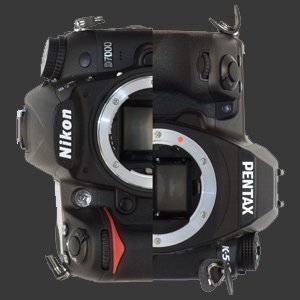
These two DSLR cameras are close competitors aimed at the same target market. A quick glance at their specifications shows a great number of similarities:
- 16 Megapixels CMOS 1.5X-crop sensor
- 100% Coverage viewfinder
- Weatherproof construction
- Dual control-dials
- Full 1080p HD video
- High-speed continuous drive
- 1/8000s-30s Shutter-speeds
- 3" LCD with 920K pixels
- Top backlit status LCD
- Built-in flash & Hot-shoe
- DOF-Preview
In reality, this goes beyond specifications since the CMOS sensor used in both the K-5 and D7000 is produced by Sony using the same state-of-the-art technology. This is why the image quality is extremely similar. A number of independent tests confirm this. DXOMark which gives a score of 82 to the K-5 and 80 to the D7000 considers such a difference too small to be perceptible. So, instead of trying to figure out which 3 pixels come out better on one camera, we leave it as no practical differences in image quality.
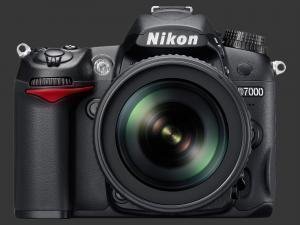
Before moving on, it is worth pointing out that ultimate quality depends on the medium and internal processing. This explains why cameras with equivalent measured image quality still produce visibly different output. Scores from DXOMark are normalizes for a non-resolution limited print size and only measures differences using RAW files to avoid certain issues.
The final point about image quality is that a single number cannot represent image quality. There are too many variables. Behind most scores there are usually several measurements that get weighted together based on subjective preferences. Even DXO uses at least bit-depth, dynamic-range and noise measurements at every ISO sensitivity to derive their final score. For some subjects a camera with a lower score may actually produce better results.
Pentax K-5 & Nikon D7000 Major Differences
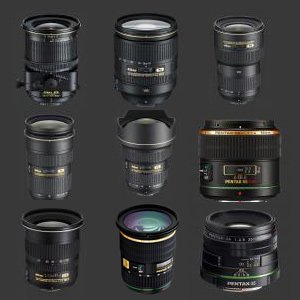
There are actually two high-impact differences between the Nikon D7000 and Pentax K-5. The first one is the lens mount. Nikon has its own F-mount and Pentax has its K-mount. Each lens mount gives access to their respective manufacturer's lens lineup:
- Nikon presently produces 63 lenses, all compatible with the D7000.
- Pentax produces 30 lenses, all compatible with the K-5.
- Major third-party manufacturers produce 76 Nikon-mount lenses.
- Major third-party manufacturers produce 50 Pentax-mount lenses.
Those numbers alone are only part of the story. Each lineup has unique offerings. Pentax owners have long-complained about limited telephoto reach. Indeed, the longest lens still produced by Pentax is a 300mm
Pentax DA* 300mm F4 ED(IF) SDM while Nikon produces a 600mm one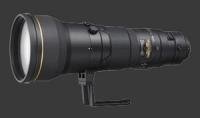
Nikkor AF-S 600mm F/4G ED VR. There are also more ultra-wide-angle options for Nikon, particularly high-quality ones. Nikkor is also the only one of these two brands to offer tilt-shift lenses.
While Nikon wins by numbers, there are advantages to the Pentax lens lineup. Pentax has more small lenses and the majority are of extremely high-qualityAs opposed to cheap lightweight lenses made of more plastic., saving bulk and weight. The Pentax lineup is mostly designed for cropped-sensorsSome of their older lenses have full-frame coverage though.. Unusual focal-lengths like the Pentax FA 31mm F1.8 Limited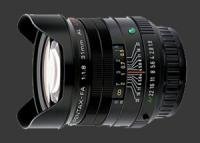
Pentax FA 31mm F1.8 Limited equates to a normal prime lens while the Pentax FA 77mm F1.8 Limited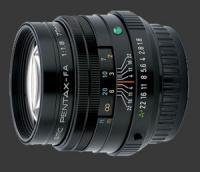
Pentax FA 77mm F1.8 Limited is considered ideal for portraits. Zooms like the Pentax DA* 16-50mm F2.8 ED AL (IF) SDM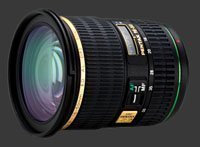
Pentax DA* 16-50mm F2.8 ED AL (IF) SDM and Pentax DA* 50-135mm F2.8 ED (IF) SDM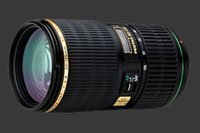
Pentax DA* 50-135mm F2.8 ED (IF) SDM correspond to classic full-frame zooms of 24-75mm and 70-200mm. They also have a neat fisheye-zoom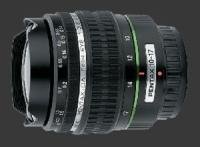
Pentax DA 10-17mm F3.5-4.5 ED (IF) Fish-Eye.
The second high-impact difference is image-stabilization. The Pentax K-5 uses a built-in stabilization system, called Shake-Reduction, that reduces the effects of camera shake for all lenses. For Nikon DSLRs, stabilization is provided by Vibration Reduction (VR) lenses. The additional cost of stabilization must therefore be incurred for each lens.
Much more importantly, stabilization is not available for all types of lenses. Particularly, very few bright lenses are stabilized. With Pentax, all lenses benefit from stabilization and this includes bright zooms, fast primes and even fisheye lenses. The two versions of the Nikkor AF-S 200mm F/2G ED VR II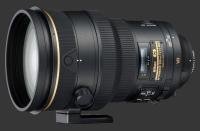
Nikkor AF-S 200mm F/2G ED VR II are Nikon's brightest stabilized lenses. A few F/3.5 general purpose zooms have VR too. On the other hand, even the Pentax DA* 55mm F1.4 SDM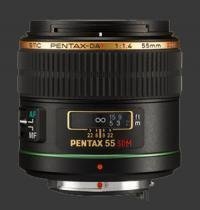
Pentax DA* 55mm F1.4 SDM and their F/1.8 Limited lenses benefit.
The K-5, like the K-7 before it, use its Shake-Reduction system to automatically take level photos by rotating the sensor ±2° to compensate for camera tilt. This has an immense benefit as paying attention to the digital-level requires additional concentration while framing. While correcting tilt by software is possible, any small rotation is detrimental to image quality and is roughly equivalent to slightly blurring the entire image.
Pentax K-5 & Nikon D7000 Performance
There is more to image quality than simply sensor performance, which we already know to be incredibly close for these two DSLRs which share a sensor. RAW shooters have less to worry about because color and white-balance are taken out of the equation. JPEG shooters will be happy to know that there are image parameters to tune colors and white-balance of both the Nikon D7000 and Pentax K-5 to a high level of realism.
Sharpness is dependent on lenses and, given the number of lenses available for each camera, is beyond the scope of this article. Both Pentax and Nikon have multiple grades of lenses with prices to match. Sharpness is known to be exceptional for high-end lenses of either brand.
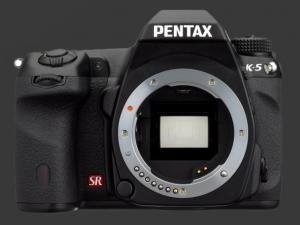
Metering options for both cameras include Multi-SegmentNikon calls it Matrix, Center-Weighed and Spot. The Nikon D7000 also does average metering. The most complex metering modes is Multi-Segment. This is probably the mostly used mode for general photography, particularly when working fast is important. Neither camera is perfect and both occasionally overexpose but the Pentax K-5 does it much less often.
Speed is an important aspect of performance for certain types of photography. By far the most critical aspect is shutter-lag with both cameras managing under ¼s. There is perceptibly less black-out with the D7000 though.
Next is autofocus speed which is difficult to precisely compare because it depends on the lens and its how far off-focus it is. That being said, the D7000 features a more sophisticated 39-point AF system versus the K-5's 11-point system. After shooting over 1000 frames on each camera, it clearly shows that the D7000 is a notch above the K-5 in terms of autofocus speed. This is even more noticeable during continuous autofocus (AF-C) where the D7000 tends to keep up with movement while the K-5 is frequently catching up towards the subject.
Both cameras are very responsive and show good performance for most operations. There are two situations where these DSLRs sufficiently differ in terms of speed. The time-to-first-shotThe time it takes to power on the camera and take a photo is faster on the Nikon D7000. The time-to-instant-reviewThe time for the instant-review to appear after taking a shot is also faster on the Nikon, taking ¾s vs 1½s. Both cameras offer some kind of automatic in-camera correction of lens aberrations. While this only adds a ½s to the D7000, it adds a whopping 2s to the K-5 before the instant-review appears.
Pentax & Nikon D7000 Ergonomics
These two DSLRs have great ergonomics with enough direct controls to satisfy pros. While neither is perfect, it is only a matter of time before being truly familiar with either one. After extended use, it shows that the Pentax K-5 has a generally more thoughtful design and better ergonomics.
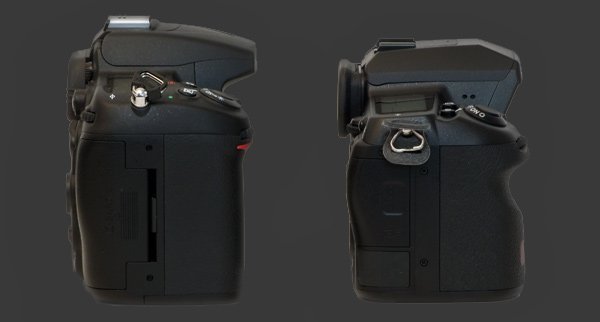
The K-5 is more comfortable to hold. A look at its sculpted grip shows a finger-indentation which helps supports the camera. Another point is that the viewfinder cup protrudes more on the K-5, so you do not have to press as much against the camera. While the control-dials have a similar position on each camera, the front one is both angled and closer to the shutter-release which makes it quicker to reach on the Pentax. The rear control-dial is also more comfortable to use on the Pentax, since it is further from the edge of the camera.
The D7000 also has its strong points for comfort. Being almost 1cm taller lets it have a taller grip. Depending on the size of your hands, this can mean the difference between having your pinky on the grip or below it. Rear buttons are mostly to the left of the LCD with only a few important controls high-up on the right. If you prefer to use a hand-strap rather than the typical neck-strap, this is much better since a hand-strap restricts your right hand's movements and usually makes it impossible to reach low buttons. The K-5 has functions assigned to its 4-way controller and most of them become nearly impossible to reach when using a hand-strap.

The Pentax K-5 has a more logical button assignment. On top of the grip, it has the EC button towards the inside and the ISO button next to it. Both these buttons occupy prime real-estate and correspond to the most highly used functions. The viewfinder also reflects any changes made using these buttons. As for the D7000, the EC button is on the least comfortable outer-edge and the button next to it, Metering, is used much less often than ISO. On top of that, its status is not shown in the viewfinder, so operating at eye-level makes little sense. With the Nikon D7000, the ISO button is unfortunately found among a column of indistinct buttons. At least both these cameras only need to use their ISO button in Manual mode since they can assign the otherwise unused control-dial to control ISO directly.
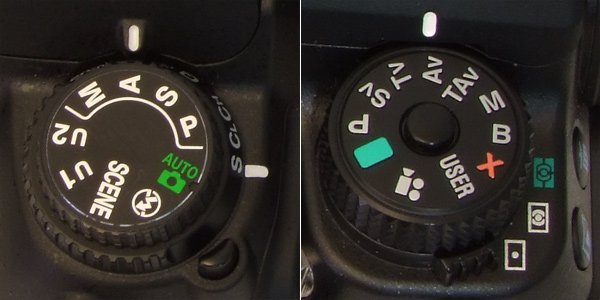
Even though the K-5 has more exposure modes, its mode-dial is much better organized. Program (P), Aperture-Priority (A) and Manual (M) modes are almost the same on both these DSLRs, except that Nikon hid Bulb (B) and Flash-Sync (X) mode as the last two shutter-speeds reachable in Manual mode. This makes it slow to reach them. In Manual mode, pressing the Green button on the K-5 sets it to the metered value according to P mode. Program mode on the Pentax, called Hyper-Program actually, can be instantly shifted into A or S mode using the control-dials. Shutter-priority is labeled S on the Nikon and T, for time, on the Pentax. This lets the Pentax introduce S mode as Sensitivity-Priority. They also have a TAv mode which lets the photographer set both shutter-speed and aperture while the camera takes charge of sensitivity. Finally, the K-5 has a dedicated Movie mode that lets it accurately preview video framing and instantly start filming. The D7000 barely manages to do the former but not the latter.
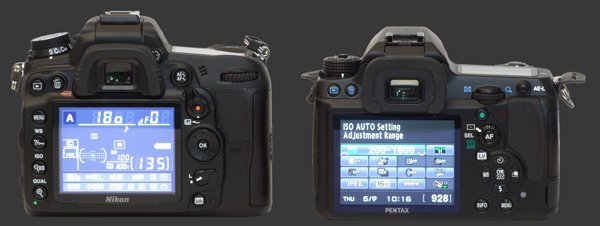
There are literally dozens of usability differences between these cameras but only some significantly impact use in the field. These digital cameras offer automatic and manual focus-point selection. There is nothing to worry about for automatic selection. Manual selection uses the directional controller on both cameras. However, the K-5 also uses its 4-way controller to activate important settings like white-balance and drive-mode. In order to do both, the camera must be switched between function and focus-point-selection. To do so, you have to hold down the OK button for 1s. Compare this to the Nikon's always-availableTechnically it can be locked to prevent accidental changes. 8-way controller and it is easy to see that its system is faster.
Photography often requires making changes to camera settings. Some changes are more often done under pressure, which is why professional cameras have so many controls. Once settings are changed to make a shot - or a series of shots - those changes have to be undone. Forgetting to unset settings like EC, WB and even ISO are some of the most common mistakes. Pentax has long had settings in its cameras controlling which settings get reset on power off. There are 13 such settings on the K-5. This lets it start at a known state each time it is turned on. Furthermore the K-5's Green button can be used to reset exposure, ISO, program shift, white-balance fine-tuning and composition-adjustment, depending on the operation in progress. The D7000 has a two-button global reset that changes too many settings to be desirable, including image quality which is usually permanently set based on the photographer's preference.
Conclusion
Reading this conclusion should not be necessary. If you read this whole article simply counting the favorable points of each camera, you missed the point. Each difference and feature must be related to your photographic needs. Take autofocus as an example, some people always use the center point and a slower way to choose an AF-point wont affect them.
The differences shown above point to several likely conclusions:
- Action, sports and wildlife photographers have great reasons to prefer the Nikon D7000, particularly faster continuous autofocus and longer telephoto lenses.
- Available light photography favors the K-5 thanks to built-in stabilization combined with bright lenses.
- Travel photographers where total weight is critical have more flexibility with a K-5. The existence of light-weight weather-sealed Pentax lenses greatly helps.
- Architecture photographers favor the Nikon D7000 which has easily-available tilt-shift lenses.
- The Nikon D7000 generally shoots faster while the Pentax K-5 is faster to operate under most circumstances.
Take the conclusion you like or make your own and get yourself a new camera!
Please Support Neocamera
All information on Neocamera is provided free of charge yet running this website is a huge endeavor. Purchases made via affiliate links found throughout the site help keep it running and up-to-date. There is no additional cost to you, so please consider buying via these links to our affilates:
Thank you for your support!
Pentax & Nikon D7000 Features
The Pentax K-5 and Nikon D7000 are quite full-featured and certainly cover all important features required for photography. While each can do things the other one cannot, the K-5 has a substantially larger feature set. Nikon obviously sells higher-end gear, so they may have been reluctant to put everything in the D7000. Not all features are useful to everybody, so the list below is mostly for finding out which one you would use.
- The K-5 has an extended ISO range of 80 to 51200, versus 100 to 25600 for the D7000. On the low side, the difference between 80 and 100 is minimal. If you truly need lower ISO sensitivity, using an ND-filter will give more latitude. On the high side, the extra 51200 is a full stop more sensitive but also a full-stop lower quality. Honestly, we do not consider this extra stop useful, so no real difference here.
- The top speed of the K-5 is 7 FPS, while the D7000 is 6 FPS. This is also a minimal difference which looks good on paper but does not translate much into results.
- The short 2s self-timer and 3s remote timers on the K-5 are perfect. They each automatically lock-up the mirror and turn off image stabilization on start. This is exactly what has to be done but Nikon users have to do it themselves: VR needs to be turned off on the lens barrel - and back on later - yet Mirror Lock-Up is exclusive of the self-timer but not of the remote. The Nikon D7000 has a work-around called Exposure Delay Mode buried in the Custom Setting menu that is obviously slow to set and unset.
- Bracketing on the K-5 can take 5 images vs 3 for the Nikon. The maximum step size is 2 EV on both, so the K-5 can spread ±4 EVs. This makes it quicker to bracket for HDR. Speaking of HDR, the Pentax K-5 can also automatically merge a 3-frame bracket directly in the camera. Again, it is quicker but all of this can be done manually with the D7000 and appropriate software.
- The Nikon can bracket for Exposure & Flash, Exposure Only, Flash Only, WB or Active D-Lighting. The K-5 can bracket for Exposure, WB, Saturation, Hue, High/Low Key, Contrast and Sharpness. Although the K-5 has a longer list, everything expect Exposure can be done later from a RAW file. The D7000's flash bracketing options are far more useful.
- The K-5 has a sync-port for external lighting in addition to a hot-shoe like the D7000. With the advent of wireless remote flash-triggers, sync-ports are finding less use though.
- The D7000 has a higher flash-sync speed of 1/320s vs the K-5's 1/180. With a compatible Speedlight, the D7000 can also automatically use high-speed sync.
- One of the most unique Pentax K-5 feature is Composition Adjustment. This lets the camera physically shift and tilt its sensor. It performs corrections like a shift-lens at no extra cost but with much less latitude.
- Both the D7000 and K-5 have digital levels showing tilt in the viewfinder. Exposure parameters remain visible while showing the level on the Pentax. The K-5 can also show pitch on the rear LCD.
- The K-5 has separate AE-L and AF-On buttons. The D7000 has a combined AE-L/AF-L button which can be configured to do AE-L, AF-L or AF-On.
- Catch-In focus is supported by the K-5 which automatically takes a shot when a subject moves into focus.
- Colors of the K-5's LCD are adjustable to improve the accuracy of images shown.
- The LCD of the K-5 can also show where dust is located using a feature called Dust-Alert.
- Pentax implemented a unique post-shot RAW capture. This lets the photographer decide after-the-fact to save a RAW file for later processing. Pentax RAW files can also be processed directly on the camera, so you can save a shot with incorrect WB, for example, by combining both of these features.
- Both these DSLRs offer Interval and Multiple exposure capabilities. The D7000 can take up to 9 shots at each interval compared to 1 shot for the K-5. For multiple-exposure, the K-5 can combine up to 9 shots while the D7000 up to 3.
- The Nikon D7000 offers dual memory-card slots which can be used in different ways. The most significant advantage is that it can write files in duplicate to both memory cards, creating backups on the fly.
Updates
2025.11.13

Best Gifts for Photographers in 2025 by Budget
The annual Neocamera Photography Gift Guide updated to 2025. Find great gifts for photographers with any price budget.
2025.07.07

Stellar Photo Recovery Review
Review of Stellar Photo Recovery V12. This Windows and MacOS software can recover photos and videos in a huge number of formats from memory cards, USB drives, SSDs and HHDs.
2025.05.14

Huion Kamvas 13 Gen 3 Review
In-Depth review of the Huion Kamvas 13 Gen 3 Pen Display Tablet for photographers and graphic artists.
2025.01.18

Fujifilm GFX 2025 Lens Roundup
Lens Review roundup of Fujifilm GFX Medium-Format lenses. Quality, performance and handling of the GF20-35mm F/4R WR, GF30mm F/3.5 Tilt-Shift and the GF55mm F/1.7.
2024.11.18

Best 2024 Photography Gifts for Every Budget
Great gifts for photographers and photo enthusiasts selected for every budget among the best products of 2024.
2024.08.07

Eye Protection Tips for Professional Photographers
The four main considerations for professional photographers regarding eyewear.
2024.07.14

Fujifilm X100VI Review
Flagship fixed-lens compact digital camera with a 40 MP sensor and Image-Stabilization, a first for the series. Retro design featuring dual control-dials, plus direct ISO, Shutter-Speed and EC dials. Its hybrid viewfinder can switch between EVF and OVF mode.
2024.05.09

Fujifilm GFX100 II Review
Flagship 102 Megapixels Medium-Format Mirrorless Digital Camera with 8-Stop 5-Axis IBIS, 8 FPS Drive, 8K Video and 400 MP Super-Resolution capture in a weatherproof and freezeproof body with dual control-dials and dual memory-card slots.
2024.04.03

Fujifilm X-T5 Review
Newest Fujifilm flagship boasting a 40 MP APS-C sensor, 5-axis IBIS with 7-stop efficiency, 15 FPS continuous drive, 6.2K Video capture, dual control-dials and dual SDXC UHS-II slots in a sturdy weatherproof and freezeproof body.
2023.11.20

Best Digital Cameras of 2023
Find out which are the Best Digital Cameras of 2023. All the new Mirrorless Digital Cameras from entry-level to high-end professional.
2023.07.10

Fujifilm X-H2 Review
40 Megapixels APS-C Hybrid Mirrorless Digital Camera with 7-stop IBIS. Fastest shutter ever and 8K video capture. Large builtin EVF with 0.8X magnification and 5.8 MP, plus an Eye-Start Sensor. Packed with features and large number of controls in a weatherproof and freezeproof body.
2023.05.07

Sony FE 20-70mm F/4G Review
Review of the unique Sony FE 20-70mm F/4G lens. The optical zoom of this lens spans ultra-wide-angle and medium focal-length coverage, making it one of the most versatile Full-Frame lenses on the market.
2025.11.13
2025.07.07
2025.05.14
2025.01.18
2024.11.18
2024.08.07
2024.07.14
2024.05.09
2024.04.03
2023.11.20
2023.07.10
2023.05.07
NEWS
2025.12.02

Sony Upgrades Alpha 7 to 5th Generation
Digital Camera ○ Lens
2025.11.29

Venus Optics Releases New Zero-D Tilt-Shift Macro Lens
Lens
2025.11.23

Best Digital Cameras of 2025
Digital Camera
2025.11.14

Photography Gift Guide 2025 Edition
2025.11.06

Canon Announces Third-Generation R6 Mirrorless
Digital Camera ○ Lens
2025.10.23

Fujifilm Launches X-T30 III Plus New Wide Zoom
Digital Camera ○ Lens
2025.10.21

Peak Design Unveils Field Plate and Form Straps
2025.10.16

Nikon Unveils Z-Mount DX Lens Duo
Lens
2025.10.16

Venus Optics Unveils Fast Telephoto Prime Lens
Lens
2025.10.01

Think Tank Photo FocusPoint RollTop Backpacks
Bag
2025.09.30

Sony Produces Super Macro GMaster Lens
Lens
2025.09.17

Venus Optics Created First Telephoto Ultra-Macro Lens
Lens









